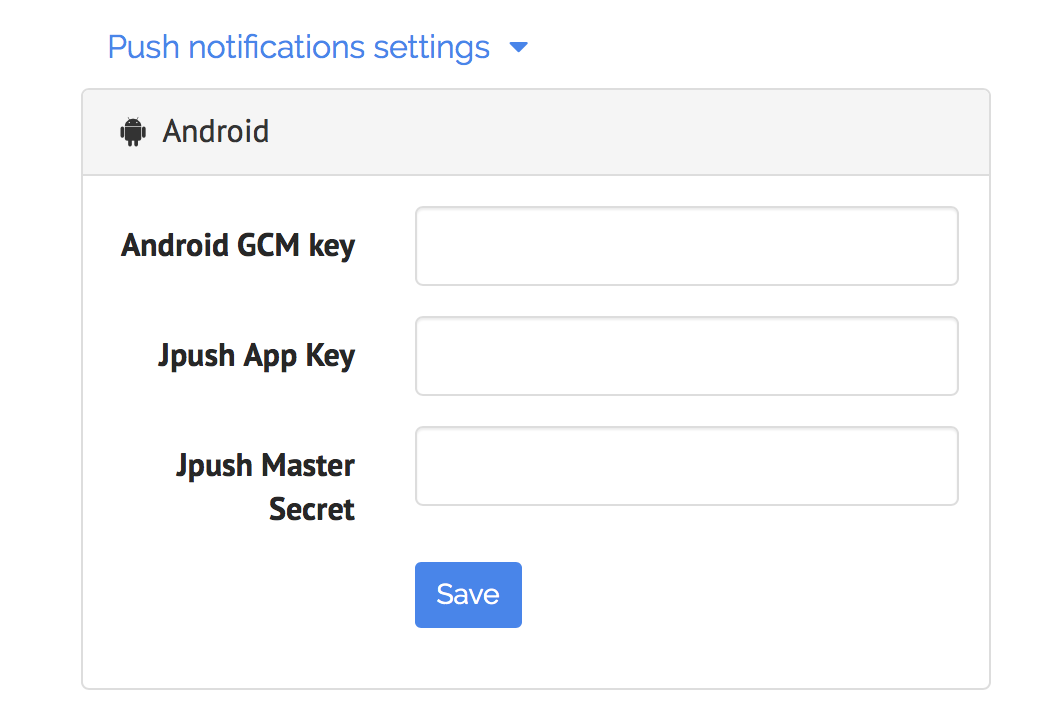- Change KeyboardHandleLayout to StickersKeyboardLayout
- Create instance of StickersKeyboardController and pass all necessary arguments(see Showing stickers fragment)
- Now you can remove all clicks handlings from stickers buttons, icon changing, keyboard size listeners, etc. All this work will be doing by controller.
- About
- Installation
- Usage
- Search
- Push Messages Support
- Customization
- Statistics
- Issues
- Credits
- Contact
- License
Stickerpipe is a stickers SDK for Android platform. This sample demonstrates how to add stickers to your chat. If you want to build your own implementation, you can use our public api.
If you use Eclipse IDE - follow this instructions.
Add stickers repository in build.gradle:
repositories {
maven { url 'http://maven.stickerpipe.com/artifactory/stickerfactory' }
}
Add library dependency in build.gradle:
compile('vc908.stickers:stickerfactory:x.x.x@aar') {
transitive = true;
}
List of available versions you can find here
Add content provider with your application package to manifest file:
<provider
android:name="vc908.stickerfactory.provider.StickersProvider"
android:authorities="<YOUR PACKAGE>.stickersProvider"
android:exported="false"/>
Initialize library at your Application onCreate() method
StickersManager.initialize(“YOUR-API-KEY", this);
You can get your own API Key on http://stickerpipe.com to have customized packs set.
User id required, and need for retrieving stickers packs. Set it to sdk, when you receive user id.
StickersManager.setUserID("some unique user id");
This add ability to make purchases, manage their packs and don't lose them after reinstalling.
You can obfuscate user id before setting it to sdk using md5 method from our Utils class
StickersManager.setUserID(vc908.stickerfactory.utils.Utils.md5("some unique user id, email, etc"));
If you system does not operate with user id, you can use device id instead
StickersManager.setUser(vc908.stickerfactory.utils.Utils.getDeviceId(this);
Also you can send user related data, such as age or gender
Map<String, String> userData = new HashMap<>();
userData.put(User.KEY_GENDER, User.GENDER_MALE);
userData.put(User.KEY_AGE, String.valueOf(30));
StickersManager.setUser("some unique user id", userData);
We created some additional classes, to help you integrate stickers keyboard naturally to your app. You still can simply create StickersFragment and use them, but we recommend our approach with StickersKeyboardController. This will make your integration more simple and give users more positive experience. See example for more details.
First of all, you need to create layout with following structure
<vc908.stickerfactory.ui.view.StickersKeyboardLayout
android:id="@+id/sizeNotifierLayout"
xmlns:android="http://schemas.android.com/apk/res/android"
xmlns:app="http://schemas.android.com/apk/res-auto"
android:layout_width="match_parent"
android:layout_height="match_parent">
<RelativeLayout
android:id="@+id/chat_content"
android:layout_width="match_parent"
android:layout_height="match_parent">
<!-- YOR CONTENT -->
<vc908.stickerfactory.ui.view.BadgedStickersButton
android:id="@+id/stickers_btn"
android:layout_width="@dimen/material_48"
android:layout_height="@dimen/material_48"
android:background="?android:attr/selectableItemBackground"/>
</RelativeLayout>
</RelativeLayout>
<FrameLayout
android:id="@+id/frame"
android:layout_width="match_parent"
android:layout_height="240dp"
android:layout_alignParentBottom="true"
android:visibility="gone"/>
</vc908.stickerfactory.ui.view.StickersKeyboardLayout>
- Your layout need to be wrapped into StickersKeyboardLayout, for handling keyboard visibility changes.
- Your content need to be placed in a ReleativeLayout near frame for stickersFragment
- You need to use BadgedStickersButton as button for showing and hiding stickers keyboard.
Then, at your activity, you need to do next steps
- Create StickersFragment instance and place it to frame
stickersFragment = new StickersFragment();
getSupportFragmentManager().beginTransaction().replace(R.id.frame, stickersFragment).commit();
- Create StickersKeyboardController and pass necessary items
stickersKeyboardController = new StickersKeyboardController.Builder(this)
.setStickersKeyboardLayout(stickersLayout) // parent layout
.setStickersFragment(stickersFragment) // stickers fragment
.setStickersFrame(stickersFrame) // frame for stickers
.setContentContainer(chatContentGroup) // your content layout
.setStickersButton(stickerButton) // stickers button
.setChatEdit(editMessage) // edit text from chat
.build();
- Add functionality for hiding stickers keyboard
@Override
public void onBackPressed() {
if (!stickersKeyboardController.hideStickersKeyboard()) {
super.onBackPressed();
}
}
- If you want listen visibility changes of keyboards(soft and stickers), you can add own listener
stickersKeyboardController.setKeyboardVisibilityChangeListener(new StickersKeyboardController.KeyboardVisibilityChangeListener() {
@Override
public void onTextKeyboardVisibilityChanged(boolean isVisible) {
// your code
}
@Override
public void onStickersKeyboardVisibilityChanged(boolean isVisible) {
// your code
}
});
If you wan to hide soft keyboard, you can use KeyboardUtils
KeyboardUtils.hideKeyboard(yourContext, someView);
To send stickers you need to set listener and handle results
// create listener
private OnStickerSelectedListener stickerSelectedListener = new OnStickerSelectedListener() {
@Override
public void onStickerSelected(String code) {
// send message
}
@Override
public void onEmojiSelected(String emoji) {
// append emoji to edit
}
};
// set listener to your stickers fragment
stickersFragment.setOnStickerSelectedListener(stickerSelectedListener)
Listener can take an emoji, so you need to check code first, and then send sticker code or append emoji to your edittext.
// Show sticker in adapter
if (StickersManager.isSticker(message)){ // check your chat message
StickersManager.with(context) // your context - activity, fragment, etc
.loadSticker(message)
.into((imageView)); // your image view
} else {
// show a message as it is
}
You can show pack info with next code
StickersManager.showPackInfoByCode(context, stickerCode);
You can use BadgedStickersButton to indicate to user, that he has a new content
<vc908.stickerfactory.ui.view.BadgedStickersButton
android:id="@+id/stickers_btn"
android:layout_width="@dimen/material_48"
android:layout_height="@dimen/material_48"
android:layout_centerVertical="true"
android:background="?android:attr/selectableItemBackground"/>
You have an ability to clear all cached sticker from internal storage. It will clear recently used stickers to
StickersManage.clearCache()
Your users have an ability to search stickers by keywords using search tab or inline search. Make sure, you are using StickersKeyboardController for managing your layouts for better integration.
By default, search tab is enabled in sdk, but you can disable this tab by passing flag at your application class
StickersManager.setIsSearchTabEnabled(false);
To add inline stickers search to your chat, follow next steps
- Place RecyclerView above your chat Edittext
<android.support.v7.widget.RecyclerView
android:id="@+id/suggests_list"
android:layout_width="match_parent"
android:layout_height="@dimen/sp_suggest_container_height"
android:layout_above="@+id/sender_section"/>- Pass this view to StickersKeyboardController at your Activity
StickersKeyboardController.Builder.create(this)
...
.setSuggestContainer(suggestsList)
.build();
You have an ability to add push notifications to sdk. There are two ways - use GcmIntegration module or use own notification system
If your application don't have gcm functionality you need to follow next steps
- Add dependency at your build file. List of available versions you can find here
compile('vc908.stickers:gcmintegration:x.x.x@aar'){
transitive = true;
}
- Add receiver at your Manifest file and replace yor_package_name with your real package name
<receiver
android:name="com.google.android.gms.gcm.GcmReceiver"
android:exported="true"
android:permission="com.google.android.c2dm.permission.SEND" >
<intent-filter>
<action android:name="com.google.android.c2dm.intent.REGISTRATION" />
<action android:name="com.google.android.c2dm.intent.RECEIVE" />
<category android:name="yor_package_name" />
</intent-filter>
</receiver>
- Retrieve Android GCM API key and store them
Follow this link and setup your application to obtain GCM API key. Next follow to your admin panel, press "Manage" and store key.
- From previous step, receive sender id and set it to GcmManager at Application class
GcmManager.setGcmSenderId(mContext, "YOUR SENDER ID");
- Implement NotificationManager, where need to define start intent for notification and icons. For pre KitKat version, we use color notification icon and monochrome(black and white) for others.
public class PushNotificationManager extends vc908.stickerpipe.gcmintegration.NotificationManager {
@Override
public int getColorNotificationIcon() {
return R.drawable.ic_launcher;
}
@Override
public int getBwNotificationIcon() {
return R.drawable.ic_notification;
}
@NonNull
@Override
public Intent createNotificationIntent(Context context) {
return new Intent(context, MainActivity.class);
}
}
- Set this manager at Application class
GcmManager.setPushNotificationManager(new PushNotificationManager());
- Add processing of intent at your activity class
@Override
protected void onCreate(Bundle savedInstanceState) {
super.onCreate(savedInstanceState);
...
checkIntent(getIntent());
}
@Override
protected void onNewIntent(Intent intent) {
super.onNewIntent(intent);
checkIntent(intent);
}
private void checkIntent(Intent intent) {
NotificationManager.processIntent(this, intent, stickersKeyboardController));
}
For better push handling, we recommend to set android:launchMode="singleInstance" to your activity.
If you have own GCM implementation, follow next steps
- Go to your admin panel, press "Manage" and store your GCM API key
- Set sender id to GcmManager at Application class
GcmManager.setGcmSenderId(mContext, "YOUR SENDER ID");
- Implement NotificationManager, where need to define start intent for notification and icons. For pre KitKat version, we use color notification icon and monochrome(black and white) for others.
public class PushNotificationManager extends vc908.stickerpipe.gcmintegration.NotificationManager {
@Override
public int getColorNotificationIcon() {
return R.drawable.ic_launcher;
}
@Override
public int getBwNotificationIcon() {
return R.drawable.ic_notification;
}
@NonNull
@Override
public Intent createNotificationIntent(Context context) {
return new Intent(context, MainActivity.class);
}
}
- Set this manager at Application class
GcmManager.setPushNotificationManager(new PushNotificationManager());
- When you receive GCM token, set it to SDK
StickersManager.sendGcmToken("GCM TOKEN");
- When you receive notification, try to process it with GcmManager first
if(!GcmManager.processPush(this, data)){
// its not stickerpipe push, implement own processing
}
When user device has no google play services, you have an ability to send push notifications via Aurora push. This integration will work only on devices without installed google play services. Make sure, that you implemented PushNotificationManager from previous steps for GCM support. Then follow next steps
- Add dependency at your build file. List of available versions you can find here
compile('vc908.stickers:jpushintegration:x.x.x@aar'){
transitive = true;
}
- Add to your manifest next items and replace YOUR-PACKAGE placeholder with your real package name
<permission
android:name="YOUR-PACKAGE.permission.JPUSH_MESSAGE"
android:protectionLevel="signature"/>
<uses-permission android:name="YOUR-PACKAGE.permission.JPUSH_MESSAGE"/>
<application
...
>
<service
android:name="cn.jpush.android.service.DaemonService"
android:enabled="true"
android:exported="true">
<intent-filter>
<action android:name="cn.jpush.android.intent.DaemonService"/>
<category android:name="YOUR-PACKAGE"/>
</intent-filter>
</service>
<receiver
android:name="cn.jpush.android.service.PushReceiver"
android:enabled="true"
android:exported="false">
<intent-filter android:priority="1000">
<action android:name="cn.jpush.android.intent.NOTIFICATION_RECEIVED_PROXY"/>
<category android:name="YOUR-PACKAGE"/>
</intent-filter>
<intent-filter>
<action android:name="android.intent.action.USER_PRESENT"/>
<action android:name="android.net.conn.CONNECTIVITY_CHANGE"/>
</intent-filter>
<intent-filter>
<action android:name="android.intent.action.PACKAGE_ADDED"/>
<action android:name="android.intent.action.PACKAGE_REMOVED"/>
<data android:scheme="package"/>
</intent-filter>
</receiver>
<activity
android:name="cn.jpush.android.ui.PushActivity"
android:configChanges="orientation|keyboardHidden"
android:exported="false">
<intent-filter>
<action android:name="cn.jpush.android.ui.PushActivity"/>
<category android:name="android.intent.category.DEFAULT"/>
<category android:name="YOUR-PACKAGE"/>
</intent-filter>
</activity>
<receiver
android:name="vc908.stickerpipe.jpushintegration.JpushReceiver"
android:enabled="true">
<intent-filter>
<action android:name="cn.jpush.android.intent.REGISTRATION"/>
<action android:name="cn.jpush.android.intent.MESSAGE_RECEIVED"/>
<action android:name="cn.jpush.android.intent.NOTIFICATION_RECEIVED"/>
<action android:name="cn.jpush.android.intent.NOTIFICATION_OPENED"/>
<action android:name="cn.jpush.android.intent.ACTION_RICHPUSH_CALLBACK"/>
<action android:name="cn.jpush.android.intent.CONNECTION"/>
<category android:name="YOUR-PACKAGE"/>
</intent-filter>
</receiver>
</application>
- Register your application at Aurora push service, obtain AppKey and Secret Master
- Add meta data to your manifest at application section and replace YOUR-APP-KEY with your value
<meta-data
android:name="JPUSH_APPKEY"
android:value="YOUR-APP-KEY"/>
- Provide your AppKey and Secret Master at Stickerpipe notification settings section
- Initialize JpushManager at your application
JpushManager.init(this);
You can replace native emoji with your custom images. You need to pass map of your codes with assosiated image name, wich can be placed at drawable or assets folders. As emoji code, you can use utf8 symbols or your custom string. This code will be return to you at callback. As param, you need to put resource location - DRAWABLE or ASSETS, and assets folder if need
// In your application after initializing sdk
LinkedHashMap<String, String> map = new LinkedHashMap<>();
map.put(Emoji.newString(0x1f496), "emoji_1f496"); // use emoji code
map.put("your_custom_string", "emoji_1f601"); // custom string as code
...
EmojiSettingsBuilder builder = new EmojiSettingsBuilder()
.setCustomEmojiMap(map)
.setResourceLocation(EmojiSettingsBuilder.EmojiResourceLocation.DRAWABLE); // or ASSETS
// .setAssetsFolder("/your/asset/folder") for assets if need
StickersManager.setEmojiSettingsBuilder(builder);
You can customize all colors by overriding values with "sp_" prefix.
<color name="sp_primary">#5E7A87</color>
<color name="sp_primary_dark">#455A64</color>
<color name="sp_primary_light">#CFD8DC</color>
<color name="sp_placeholder_color_filer">@color/sp_primary_light</color>
<color name="sp_toolbar_bg">@color/sp_primary</color>
<color name="sp_stickers_tab_bg">@color/sp_primary</color>
<color name="sp_stickers_backspace">@color/sp_primary</color>
<color name="sp_stickers_tab_strip">@android:color/white</color>
<color name="sp_stickers_list_bg">@android:color/white</color>
<color name="sp_stickers_tab_icons_filter">@android:color/white</color>
<color name="sp_stickers_empty_text">@color/sp_primary</color>
<color name="sp_stickers_empty_image_filter">@color/sp_primary</color>
<color name="sp_remove_icon">#616161</color>
<color name="sp_reorder_icon">#9e9e9e</color>
<color name="sp_primary_text">@android:color/black</color>
<color name="sp_secondary_text">#616161</color>
<color name="sp_list_item_pressed">#ffe1e1e1</color>
<color name="sp_list_item_normal">@android:color/white</color>
<color name="sp_red_500">#F44336</color>
<color name="sp_notification_icon_background">@color/sp_primary</color>
<color name="sp_tab_badge_center">@android:color/white</color>
<color name="sp_tab_badge_inner">@color/sp_red_500</color>
<color name="sp_tab_badge_outer">@color/sp_primary</color>
<color name="sp_button_badge_center">@android:color/white</color>
<color name="sp_button_badge_inner">@color/sp_red_500</color>
<color name="sp_button_badge_outer">@android:color/white</color>
<color name="sp_pack_info_message_text">@color/sp_primary</color>
<color name="sp_pack_info_message_image_filter">@color/sp_primary</color>
<color name="sp_pack_info_bg">@android:color/white</color>
<color name="sp_search_fragment_icons">#616161</color>
<color name="sp_search_fragment_text">#616161</color>
<color name="sp_search_fragment_text_hint">#a8a8a8</color>Stickerpipe SDK support English language. If your application use another languages, you need add translation for next values
<string name="sp_package_stored">Pack stored</string>
<string name="sp_package_removed">Pack removed</string>
<string name="sp_collections">Collections</string>
<string name="sp_recently_empty">We have wonderful stickers!\nSwipe left and start using</string>
<string name="sp_pack_info">Pack info</string>
<string name="sp_pack_download">Download</string>
<string name="sp_pack_remove">Remove pack</string>
<string name="sp_no_internet_connection">No internet connection</string>
<string name="sp_cant_process_request">Can not process request</string>
<string name="sp_content_is_unavailable">This content is currently\nunavailable</string>
<string name="sp_open_stickers">Open stickers</string>
<string name="sp_shop">Shop</string>
<string name="sp_tab_new">New</string>
<string name="sp_tab_top">Top</string>
<string name="sp_tab_free">Free</string>
<string name="sp_free">Free</string>
<string name="sp_shop_packs_list_promo_title" formatted="false">%s %s</string>
<string name="sp_activate">Activate</string>
<string name="sp_subscription_text">Send emotions with original Stickers! Available on premium status.</string>
<string name="sp_undo">Undo</string>
<string name="sp_reload">Reload</string>
<string name="sp_download">Download</string>To count the number of sending messages and stickers, you need call an analysts method onUserMessageSent (boolean)
AnalyticsManager.getInstance().onUserMessageSent(StickersManager.isSticker(message));
Call this method when a user sent a message
If you are using TabLayout from design library, check this issue
Stickerpipe
Stickerpipe is available under the Apache 2 license. See the LICENSE file for more information.





